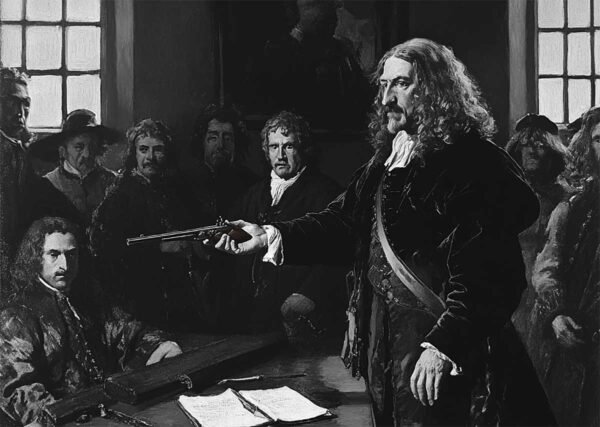Opinion

Historical accuracy plays a crucial role in shaping debates over significant issues like gun rights. When history is misrepresented or distorted, the consequences can be profound, especially when it concerns topics as contentious as the Second Amendment. Historical accuracy plays a crucial role in shaping debates over significant issues like gun rights. In an era of intense public scrutiny and pivotal court rulings on the Second Amendment, misrepresentations of history can fuel misguided policies with far-reaching consequences.
A recent example of this misrepresentation is found in Malcolm Gladwell’s Revisionist History podcast, where he explores the 1686 trial of Sir John Knight and its relevance to modern gun rights discussions. While Gladwell is an expert storyteller, his retelling of this case leaves room for confusion and, ultimately, misleads his audience about the real historical context that informs the Second Amendment.
In this article, we’ll explore how Gladwell’s retelling of Sir John Knight’s trial contributes to misunderstandings about gun rights, why historical accuracy is essential in these discussions, and how David Kopel’s fact-based critique of Gladwell’s narrative serves as a necessary corrective for anyone interested in defending the Second Amendment.
Gladwell’s Storytelling vs. Legal History
Malcolm Gladwell’s Revisionist History podcast is designed to present overlooked or misunderstood stories in a new light. However, in his episode “The Sudden Celebrity of Sir John Knight,” he takes liberties with the facts in a way that alters the historical significance of the 1686 trial. Sir John Knight was acquitted of violating England’s 1328 Statute of Northampton, which forbade the carrying of arms in public to terrorize others. According to Gladwell, this case was pivotal in shaping future debates over gun rights, including the U.S. Supreme Court’s 2022 decision in New York State Rifle & Pistol Association v. Bruen.
Gladwell suggests that the Knight case represents a “checkmate” against historical gun restrictions. However, his retelling overstates the significance of the case, painting Knight’s acquittal as a foundational moment for gun rights in English and American law.
In reality, the case played a much smaller role than Gladwell presents, particularly in how it has been used in discussions about American constitutional law.
Understanding the Statute of Northampton’s True Scope
Modern gun control advocates, including New York in the Bruen case, often cite the Statute of Northampton to argue for restrictions on public carry. However, as Stephen Halbrook notes, the statute was never intended to ban the peaceable carrying of arms—it only applied to situations where arms were carried with the intent to cause terror.
While Malcolm Gladwell leans on the Statute of Northampton to argue for historical restrictions on carrying arms, the true legal interpretation of this 14th-century statute offers a more nuanced view. The Statute forbade carrying arms in a manner that would terrify the public, specifically “in affray of the peace.” As Stephen Halbrook notes in his article, Does a Medieval English Statute Supersede the Second Amendment?, even in England, the Statute of Northampton was not a blanket prohibition on carrying arms.
The critical legal interpretation came from the 1686 trial of Sir John Knight, where the court emphasized that the statute applied only when arms were carried with “malo animo,” or malicious intent. The jury acquitted Knight because he did not go armed with the intent to terrify the public. This reinforces the principle that carrying arms for self-defense was lawful unless it was done to cause fear or harm.
Halbrook also points out that many early American laws, such as those drafted by Thomas Jefferson in Virginia in 1786, followed this principle. The Virginia law forbade carrying arms “in terror of the country,” but peaceful carrying of arms remained lawful. This is a critical distinction that undermines the broad reading of the Statute of Northampton used to justify restrictive gun laws in America today.
Misleading the Debate on Gun Rights
Gladwell’s version of the Knight case introduces several problems in the modern debate over gun rights. First, his exaggeration of the case’s significance risks convincing listeners that gun rights have a weaker historical foundation than they actually do. By focusing on a single, relatively obscure case, Gladwell ignores a wealth of more relevant historical examples that directly informed the Founders’ understanding of the right to bear arms, such as the English Bill of Rights of 1689, which declared that Protestants could “have Arms for their Defence suitable to their Conditions, and as allowed by Law.”
In his critique of Gladwell, David Kopel points out that the true significance of the Knight case lies in its legal context:
the Statute of Northampton had largely fallen into disuse by the time of Knight’s trial, and his acquittal was more about the specific circumstances of his case than any grand statement on the right to bear arms. The acquittal was based on the lack of intent to cause terror, which was a key factor under English law. Gladwell’s portrayal of Knight’s trial as a major moment in the history of gun rights, therefore, inflates its importance while ignoring the broader legal context.
The American Evolution of Gun Rights
In America, the right to bear arms evolved into something far more expansive than its English origins.
This divergence is crucial to understanding why the Second Amendment was framed without the qualifications that limited English rights. The Founders sought to enshrine an individual right that went beyond the restrictive English model, ensuring that American citizens could bear arms for self-defense without conditions based on their status or intent.
As Halbrook again notes, the Second Amendment was seen by the Founders as building on English law by explicitly protecting an individual’s right to keep and bear arms without the restrictions of “condition or degree” imposed in England. St. George Tucker, one of the earliest American commentators on the Constitution, emphasized that while English law allowed for some restrictions on the carrying of arms, the Second Amendment “was without any qualification” in its protection of gun rights.
Tucker’s interpretation illustrates the broader American view of gun rights, which went beyond England’s common law. Early American statutes continued to allow individuals to carry weapons so long as they did not do so in a way that would terrorize others.
This understanding highlights the divergence between America’s constitutional right to bear arms and the narrower restrictions in English law, further undermining the misrepresentations found in Gladwell’s narrative.
The Importance of Accurate History in the Gun Control Debate
Why does this matter? Because historical misrepresentations can fuel misguided policy decisions.
If supposedly influential figures like Gladwell portray the history of gun rights as weaker or more tenuous than it is, it opens the door for liberal policymakers to argue that modern restrictions on firearms have deeper roots in legal tradition than they actually do. This is dangerous for defenders of the Second Amendment, who rely on the robust historical foundation of gun rights to make their case against restrictive gun control laws.
The U.S. Supreme Court’s decision in Bruen rested on a thorough examination of historical precedent, including colonial and early American laws, to affirm the individual right to bear arms for self-defense. The court’s focus was on the original public meaning of the Second Amendment when it was ratified in 1791, not on isolated cases from English law centuries earlier. By focusing on the Bruen decision and the historical context that informed it, defenders of gun rights can provide a much stronger case than the revisionist narrative that Gladwell offers.
Kopel’s Corrective and the Path Forward
David Kopel’s original article, Malcolm Gladwell’s Invented Facts Make Good Stories, provides an essential counterpoint to Gladwell’s retelling of the Knight case. Kopel meticulously breaks down Gladwell’s embellishments and false claims, offering readers a more accurate and fact-based understanding of the trial and its historical context. Importantly, Kopel reminds us that while Knight’s case may be interesting, it is not the cornerstone of the gun rights debate that Gladwell suggests.
The Importance of Accurate Historical Analysis
Misrepresenting historical facts can have significant consequences for modern debates, particularly when it comes to defending fundamental rights like the Second Amendment. Malcolm Gladwell’s selective retelling of Sir John Knight’s case might be entertaining, but it risks distorting the robust historical foundation that underpins gun rights.
As both David Kopel and Stephen Halbrook demonstrate, accurate historical analysis is essential for anyone committed to preserving the Second Amendment. In a time when gun rights are frequently under attack, relying on factual, well-researched history is the only way to safeguard these freedoms.
Read Related:






Subsequent to the Statute of Northampton …
“The right of self-defense is the first law of nature; in most governments it has been the study of rulers to confine this right within the narrowest limits possible. Wherever standing armies are kept up, and when the right of the people to keep and bear arms is, under any color or pretext whatsoever, prohibited, liberty, if not already annihilated, is on the brink of destruction.” Henry St. George Tucker, in Blackstone’s 1768 “Commentaries on the Laws of England.”
I enjoyed reading Kopel’s and Halbrook’s views on the Statute of Northampton. But I think the article would have been more complete if you had also included the views of Dr. Joyce Lee Malcolm.
To Keep and Bear Arms: The Origins of an Anglo-American Right
https://www.amazon.com/Keep-Bear-Arms-Origins-Anglo-American/dp/0674893077
Perhaps a “compare and contrast” update later?
I’d dig in to it but most of my library is already packed up in preparation for a move.
The learning point for all of us is this: make your arguments water tight. WE live under truth. To our adversaries, those on the left side of the equation truth is a stranger. Power is their friend. We need to preserve the integrity of our voice not so much to convince rabid leftist ideologues but to convince those in the middle, the persuadable majority to the virtue of our arguments. WE live in a culture where many will never touch a gun until folks like us mentor and educate them. Those are the persuadable. If we speak verifiable truth they… Read more »
I don’t care who says what about anything. Second amendment or not, my right to have a gun to protect myself at all times has nothing to do with any government or any person saying that they have the right to control, put limitations on, charge for or license me as an individual or put my name in a illegal gun registry in order for me to exercise “shall not be infringed”.
Any gun law is against the law based on simple verbiage of the 2nd amendment.
Trump 2024
After WWII, educators began proclaiming that because all men are equal, all opinions are equally valid. This gave rise to the “my truth” myth prevalent in education today. Progressive pissants proudly proclaim “they are speaking their truth” when it has nothing to do with actual truth. Truth is an absolute. Something is either true or it is not. One may certainly have opinions about what is true, but one cannot have his own, personal truth. And that is what colors our understanding of the Second Amendment and encourages conflict. Those of us who claim religious faith know that God is… Read more »